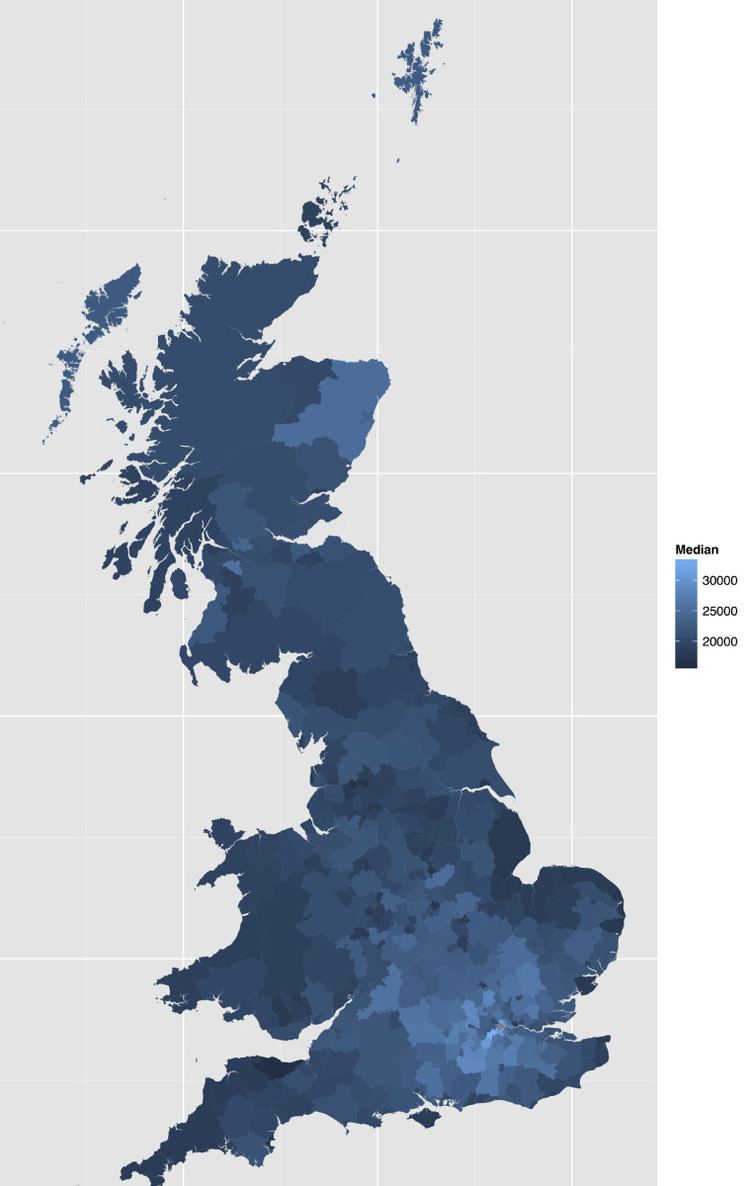 | ||
In terms of global poverty criteria, the United Kingdom is a wealthy country, with virtually no people living on less than £10 a day. In 2012-13, median income was approximately £21,000 a year but varies considerably by age, location, data source and occupation. There is both significant income redistribution and income inequality; for instance, in 2013/14 income in the top and bottom fifth of households was £80,800 and £5,500, respectively, before taxes and benefits (15:1). After tax and benefits, household income disparities are significantly reduced to £60,000 and £15,500 (4:1).
Contents
- Taxable income
- Income by location
- Income by age and gender
- Income by occupation
- Post tax household income
- Wealth
- High income
- References
The UK Gini coefficient for 2013/14 estimated at 0.34. There were 720,000 net worth Sterling millionaires in the United Kingdom in 2015 (1 in 65 adults).
Taxable income
The most recent SPI report (2012/13) gave annual median income as £21,000 before tax and £18,700 after tax. The 2013/14 HBAI report gave median household income (2 adults) as £23,556. The provisional results from the April 2014 ASHE report gives median gross annual earnings of £22,044 for all employees and £27,195 for full-time employees.
According to the OECD the average household net-adjusted disposable income per capita is $27,029 a year (in USD, ranked 14/36 OECD countries), the average household net financial wealth per capita is estimated at $60,778 (in USD, ranked 8/36), and the average net-adjusted disposable income of the top 20% of the population is an estimated $57,010 a year, whereas the bottom 20% live on an estimated $10,195 a year giving a ratio of 5.6 (in USD, ranked 25/36).
The 2013/14 HBAI reported that 15% of people had a relative low income (below 60% of median threshold) before housing costs.
Data from HMRC 2012-13; incomes are before tax for individuals. The personal allowance or income tax threshold was £8,105 (people with incomes below this level did not pay income tax).
Income by location
Income can vary considerably by location. For example, the locations (local administrative unit) with the highest incomes were the City of London, Kensington and Chelsea, and Westminster with median annual incomes of £58,300, £37,800 and £35,200 respectively. The locations with the lowest incomes were Hyndburn, Torbay, and West Somerset with median annual incomes of £17,000, £16,900 and £16,000 respectively.
Income by age and gender
Data from the Survey of Personal Incomes 2012/13.
Income by occupation
The tables below shows the ten highest and ten lowest paid occupations in the UK respectively, as at April 2014.
Post tax household income
Data from the Households Below Average Income (HBAI) report from the Department of Work and Pensions 2013/14:
Data from HMRC – Percentile points of the income distribution as estimated from the Survey of Personal Incomes, note this only includes individuals who pay some income tax:
Wealth
The net worth information is based on data from HMRC for 2004–2005 and includes marketable assets including house equity, cash, shares, bonds and investment trusts. These values do not include personal possessions.
High income
The Institute for Fiscal Studies issued a report on the UK's highest earners in January 2008. There are 42 million adults in the UK of whom 29 million are income tax payers. (The remainder are pensioners, students, homemakers, the unemployed, those earning under the personal allowance, and other unwaged.) A summary of key findings is shown in the table below:
The top 0.1% are 90% male and 50% of these people are in the 45 to 54 year age group. 31% of these people live in London and 21% in South East England. 33% of these people are company directors (as reported to HMRC). 30% work in finance and 38% in general business (includes law). The very richest rely on earnings (salary and bonuses) for 58% of income. Income from self-employment (such as partnerships in law or accountancy firms) accounts for 23% of income and about 18% from investment income (interest and share dividends).
